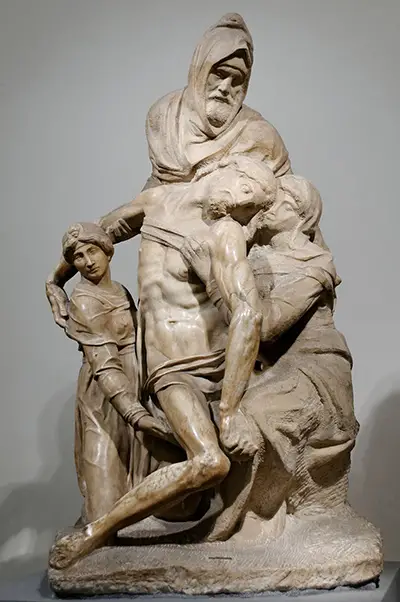He begin carving sometime after 1550 (exact dates vary depending on source) and finished his part of the sculpture in 1555, although Michelangelo did not complete the sculpture himself.
The Deposition was not a commissioned work and may have been originally destined for Michelangelo's own tomb, although he later sold it incomplete.
The sculpture depicts the body of Jesus Christ being taken down from the crucifix prior to embalming. Carrying him is the priest Nicodemus, who bought luxurious embalming spices, the Virgin Mary and also Mary Magdalene.
Bible passages featuring Nicodemus form the idea of being 'born again' into Christian belief. The story of the Deposition in the Bible itself has Christ being carried from the cross by Nicodemus and Joseph of Arimathea, leading some art historians to believe that the figure of Nicodemus is actually Joseph. Most agree that Nicodemus was carved as a self-portrait of Michelangelo.
Because it features the Virgin Mary, The Deposition is known as the Florentine Pietà, as 'pietà' is the term for artwork that depicts the Virgin Mary. Michelangelo previously created the Roman Pietà, although 'Roman' is only used when distinguishing between the two. The Roman version was sculpted when Michelangelo was only 24. It would take him until age 72 to embark on his Florentine passion project.
Michelangelo appears to have enjoyed taking his time over the sculpture, but his servant, Urbino, was eager for him to finish. The sculptor had chosen a veined marble to carve, which is more difficult.
It is not known whether these two factors definitely contributed to Michelangelo's rage, but one day he had had enough. Taking up his hammer, he struck the sculpture repeatedly, damaging Christ's left arm and leg, as well as removing several parts of the sculpture.
After this incident, he couldn't bring himself to do anymore work, and gave the unfinished piece to a wealthy businessman, Francesco Bandini. Other theories about Michelangelo's rage at The Deposition include a crisis of his faith or a fear that he would be outed as a follower of Nicodemus, whose teachings were closer to that of the Protestant Church. As is the case today, the Italy of Michelangelo was overwhelmingly Catholic.
Yet another theory suggests Michelangelo was unhappy with his carving of Christ's leg as it appears to be draped over the body of Nicodemus. He may have considered this inappropriately sexual, and this would explain why he attacked this part of the sculpture.
Bandini hired Tiberio Calcagni to complete work on the sculpture. Calcagni was a friend of Michelangelo's and so familiar with his work. He had assisted him on other projects. He improved upon the hammer damage, reattaching most of the broken parts with the exception of Christ's left leg.
He finished sculpting Mary Magdalene, though his depiction of her was not without controversy. Previously, Mary's face had mirrored that of the Virgin Mary in displaying anguish at Christ's suffering. Calcagni's version gave Mary a more neutral expression, leading her to seem detached from the action.
The Virgin Mary, however, was always depicted with a look of anguish, central to the theme of the Pietà. One theory is that the sculpture depicts Christ's deliverance back into the arms of his mother. However, the presence of Mary Magdalene suggests that instead this is a depiction of Christ's entombment. There is a possibility that all of these interpretations are correct, as loading an artwork with multiple meanings was gaining in popularity at this time.
The Bandini family eventually sold the sculpture to Cosimo III in 1671. He had it displayed in a variety of museums in Florence. Today, The Deposition resides in Il Grande Museo del Duomo in Florence. The museum is dedicated to the Cathedral and contains many religious works of art. The Deposition is the Museo dell'Opera, which actually has nothing to do with musical opera.


